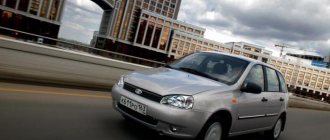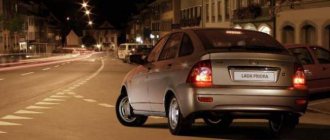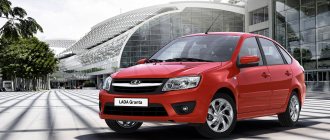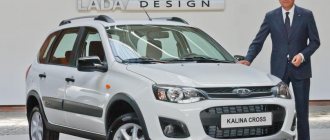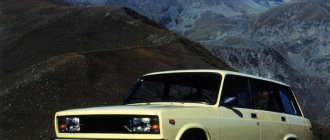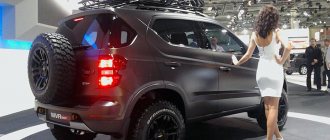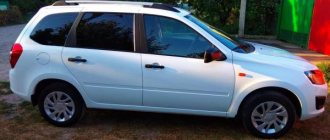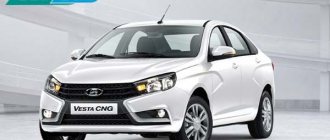The automobile market is developing at incredible speed. Some are developing electric cars, others are winning Car of the Year awards. In recent years, so-called hot hatches have become very popular. These are sports versions of civilian hatchbacks. The founder of this class is Volkswagen with its Golf GTI model. Years passed, but AvtoVAZ continued to produce standard Kalinas and Prioras without technical changes. But in 2015 the picture became clearer. The domestic manufacturer presented to the public a new version of the Russian hatchback - “Kalina NFR”. Technical characteristics, design and reviews are further in our article.
Design
Features are visible in the car. However, something is still wrong here.
The first thing your eye catches is the huge 17-inch alloy wheels on low-profile tires. The car also has powerful air intakes on the hood. To prevent leaves and other foreign objects from falling into the engine compartment, these openings are protected by a black metal mesh. You will notice that there are also air intakes at the bottom of the bumper.
At the rear, the Lada-Kalina-Sport NFR differs from civilian versions by the presence of a spoiler. The body architecture is very well done. The car cannot be called ugly or disproportionate. And although the civilian version was taken as a basis, as a result the designers managed to get a real “charged” hatchback. But do not forget that this is not a production version. It is assembled at a separate plant. About 50 copies were produced in 2015.
Results
What is the Lada-Kalina NFR car, the characteristics of which are presented in the article? Of course, this car is in an inexpensive price category and fully complies with all sports transport standards. NFR is also suitable for everyday driving, but there are some nuances. For example, the seats are not ergonomic and comfortable.
Official dealers sell cars of this brand. The car is suitable for both short and long trips. The cost greatly depends on the installed suspension. In modifications that contain components from Renault, the price can exceed 700 thousand Russian rubles. And if you have any doubts about whether to buy it, you should know that the car is really worth it.
Salon
In addition to the exterior, improvements were also made to the interior. There is a modified steering wheel and a different instrument panel with red edging on the scales. The interior features perforated leather inserts. Reviews about it has a comfortable grip on the steering wheel. There is also a “zero” line, like on real sports cars. The interior is dominated by yellow stitching. The center console houses a large 7-inch display with a visor. There are two cup holders at the bottom. There are speakers on the sides, on the door cards. The sound quality is at a decent level. As for sound insulation, it is average. Don't expect silence in the cabin. Still, the price of the car makes itself felt.
When you turn the ignition key, the bright red arrows of the tachometer and speedometer light up. By the way, they swapped places in the sports version. There is an on-board computer in the center. It contains information about current fuel consumption, daily and total mileage, and also contains information about errors that have occurred. The instrument cluster was developed jointly with Ferrum. By the way, the numbers on the scales have an italic font. At first it seems uncomfortable, but over time you quickly get used to them, reviews say. The value of the gear in which the car is currently moving is duplicated on the dashboard.
What other features does the Kalina NFR have? Reviews note the comfort of the seats. In civilian versions of the Kalina, they had a large lumbar curve, which made long trips simply unbearable. Now the seats have good lateral support and wide headrests. The bright abbreviation NFR is visible on the back of the seats. During long trips, the driver does not have back pain or numb legs. There is a wide range of adjustments.
By the way, there are three of them in the back. Seat upholstery in pleasant dark colors. And there are even speakers on the passenger doors. They are also present on the rear shelf. As for the free space, it has not changed compared to the regular Kalina. The three of us sitting in the back are very cramped, reviews note. The trunk volume is also small - 240 liters. With the seats folded down, this figure increases to 550. The small dimensions of the body are to blame. After all, the length of the car is less than four meters. But this also has its advantages. Compact dimensions allow parking even in tight yards. By the way, due to the short overhangs, the car copes well with uneven roads.
Melnikov and Lada Kalina NFR in the crowd of the National racing class
Lada Kalina NFR for 850 thousand rubles - why so cheap? I drove a million dollar car! At the same time, it has only one seat, no “music” and trouble with sound insulation. Because this is a racing car of the R1 group, in which I took part in the Russian circuit racing series at the Moscow Raceway.
Kalina NFR group R1 falls into the most popular class of the Russian “ring” - National, which is more often called Emotional. But why did Lada Sport receive only two special “ring” permits for the NFR for this season? Moreover, it is prohibited to put fast racers behind the wheel of these cars - that’s why Vitaly Primak, deputy director of Lada Sport, is driving one car at this stage, and the second was entrusted to me.
The fact is that officials of the Russian Motorsport Federation consider Kalina NFR the fastest car in the class, which, in addition to it, includes Kia Rio hatchbacks, Ford Fiesta and Volkswagen Polo sedans. They say that before the start of the season on the Smolensk Ring, all cars were compared under the same conditions - a kind of balance of performance. And as a result, Polo and the old Kalina did without a handicap, Kia gained 10 kg, and the super-Kalina received 30 kg.
True, in Smolensk Ladas have always been strong - almost all races there are won by Kalinas - but in Kazan with its long straight or at Moscow Raceway the situation is changing. Maybe it would be worth expanding the handicap determination procedure?
As a result, my plan to “come, see, ride on the pedestal” immediately tripped over a bunch of steel ballast plates that covered the entire free space in the cabin of my Kalina: 1100 kg! Primak has 1070 kg, and the regular Kalina of last year’s winner in the National class, Vladimir Sheshenin, weighs 1030 kg. In terms of carrying capacity, only Roman Agoshkov in a Kia Rio, who won the previous race, could compete with me (at RSKG, ballast is recalculated after each race).
My Kalina was filled to capacity with ballast plates
But even with a “steel passenger” in the cabin, the Kalina NFR made me happy. The way it turns, the way it tells me through the steering wheel and pedals about its condition, most of all reminded me of the Ford Fiesta hatchback of the Touring-light class. Lada does not impose its character on you: you can drive the way you want, build the trajectories you need and just enjoy the ride. The engine spins confidently up to 7500 rpm, the gears in the cable-driven gearbox are engaged easily and clearly, and the steering wheel pleases with genuine effort. About two laps - and then the steering wheel turns to stone, almost sending me to the relegation zone. Somehow, firmly grasping the steering wheel with both hands, I return to the pits under the jerks of the powerful disc lock in the turns. Mechanics advise restarting the engine, this helps. True, everything repeats itself in a circle, then again and again. As a result, I completed four training sessions without the aid of an amplifier.
It turned out that the race car was mistakenly equipped with a Mando geared electric booster, which cannot handle such loads. By the way, last winter at the ice sprints he also failed at the editorial Kalina - the required unit produced by the Kaluga Avtoelectronics plant was not in stock, so he had to learn a new steering technique. And after the second session, I asked to turn off the vacuum brake booster. The pedal was too light, it was almost impossible to control the force with my left foot, and at the end of the back straight I kept locking the wheels. In the National there are not racing slicks, but semi-civilian tires Yokohama Advan A048. They have excellent adhesion properties, but you need to work with them very carefully: as soon as they overheat, Kalina seems to be on skates. In a race, everyone encounters this problem sooner or later, but it is important that the encounter occurs late.
Otherwise, I really enjoyed it. The engineer and I adjusted the settings towards sharper steering, and in qualifying I ended up eighth. According to the plan for the first race, I needed to finish approximately like this in order to free myself from some of the ballast, and then, thanks to the reverse start rule, be in front.
The brakes of the racing Kalina NFR are standard, from VAZ front-wheel drive vehicles. The civilian car has parts from Renault Megane. Racing uses 14-inch wheels, and larger brakes simply won’t fit here.
About the time I was buttoning up my overalls, the first drops fell from the sky. And on the warm-up lap it started pouring out like a bucket! My sharp Kalina, which pleased me with its instant responsiveness on a dry road, turned into a supermarket cart that turns with its rear wheels. Skid once, whip two, steering wheel all the way three - sit in a gravel trap. As my friends watching the broadcast joked, that day I became the fastest archaeologist in the world, but digging with the front wheels did not lead to anything. Thanks to the marshals, they pulled me out - and I made it to the starting field.
And it has thinned out! My teammate Andrei Petukhov went into the pits to “release” the stabilizers and change the suspension settings, but did not manage to leave on time, the same story with Vitaly Primak. They had to start from the pits, but they were right!
I remember that race in a fog. A constant suspension of water splashes, brushes that cannot cope with the flow of water, brake lights appearing out of nowhere and a constant struggle with the car. Petukhov, who started last, caught up with me already on the fifth lap, although I was not out of the top ten! In the end, Andrey managed to reach the third prize place. And I didn’t spend a second without a fight - which, alas, was not always correct. Most of all I remember Ruslan Nafikov on the Kia Rio. First, the Kazan driver hit me in the rear bumper while braking so that only the car in front of me kept my car from flying out. And then Nafikov pushed me off the track in the last turn and, as if nothing had happened, continued to move along the edge, which is why I was forced to drive on the grass!
The full version is available only to subscribersSubscribe now
I'm already subscribed
Specifications
So, let's move on to the most important thing. What are the characteristics of Kalina NFR? Under the hood there is a forced 16-valve gasoline engine. The standard VAZ “shesnar” with 1600 “cubes” was taken as the basis. The manufacturer states that the design has modified the intake system. But you shouldn't expect turbines under the hood. The power of this unit is 140 horsepower. This is one and a half times more than on a regular Kalina. Torque is 165 Nm. The car confidently handles and maneuvers in traffic. The subframe and steering rack were also modified. As for the maximum speed, the Kalina NFR accelerates to 203 kilometers per hour.
The car reaches the first hundred in 9 seconds. For comparison: the Lada-Kalina-Sport modification accelerates a second later. A 118-horsepower gasoline unit is installed here. Regarding fuel consumption, many complain about the car’s gluttony. After all, with a volume of 1600 “cubes” it reaches 10 liters in a mixed cycle. There are no other engine modifications here. In the future, the manufacturer plans to switch to the use of turbocharging, thereby increasing the power of the Kalina to 180 horsepower.
Car engine
The main advantage of the Kalina NFR car is its 1.6-liter unit. It runs on 4 cylinders. The engine was installed after testing on a VAZ-21127, where the latest software and some modified systems were installed.
The unit works together with a manual transmission, which has 5 steps. A cable drive is installed. Thanks to the latter, all the driving and braking power is transferred to the front pair of wheels. The driver only needs 8.5 seconds to accelerate to 100 km/h. The maximum speed is 200 km/h.
About the transmission
The gearbox here is only manual, with five speeds. There are no automatic transmissions here. Reviews note the ease of use of the cable-driven transmission. This box was developed jointly with German engineers. It is easy to change gears in the car, and the gearbox itself no longer buzzes as before. According to the manufacturer, this box has an increased resource. It is maintenance-free - it is filled with oil for its entire service life. So far, judging by the reviews, it does not create problems for car owners.
Technical capabilities
Experts include the use of French parts (Megane) in the suspension and braking system among the design decisions made during the production of the NFR.
The chassis has been modernized (except for the rear beam). The manufacturer borrowed the hubs from Renault, which had a positive effect on the drive. At high speeds the engine growls, and at low speeds the engine runs intermittently. The standard clutch comes in the form of long-travel pedals, which ensures smooth movement. The brake and accelerator pedals have a similar design. They are easy to manage.
Lada NFR quickly picks up speed (while maintaining speed in the red zone). When switching to 2nd gear, a “failure” is observed. After acceleration, the car continues to move at the same speed. This process is observed when the engine howls, turning into a squeal.
If the vehicle moves at a speed of more than 130 km/h, then aerodynamic noise appears. The comfort level is high. This is achieved due to the presence of a sports suspension of moderate rigidity. Shock absorbers and struts were developed by AvtoVAZ specialists. The engine crankcase is installed above the subframe. There is no motor protection. If necessary, you can install it yourself. It is recommended to use thick metal for this. Welding work is carried out with the help of professionals.
The ground clearance of the new product, unlike the regular Kalina, is 2 cm less. The low-slung sports model, high-quality damper tires with grooves, high stability and safety when cornering are the main advantages of the Kalina NFR 2. To increase ground clearance, you can install 17-inch wheels on the car or tune the support springs.
Lada NFR, like Kalina Sport, is assembled by hand.
tweet
back What is Kalina's electrical circuit?
Next What is the design of the Lada Kalina car heater
Tags appearance, NFR, technical characteristics
Chassis
The Kalina NFR car featured new shock absorbers and lowered springs. The braking system has also been improved here.
Now there are disc calipers on the rear axle. The steering rack has a lower location. Due to the stance and 17-inch wheels, the car has sporty handling. It doesn't roll when cornering. But at the same time, reviews from owners note the stiffness of the suspension. This is due to the use of gas-filled shock absorbers and low-profile tires. By the way, the braking system was borrowed from the French Renault Megane. The front suspension has a MacPherson type suspension, and the rear has a semi-independent beam. The suspension design has remained virtually unchanged compared to the regular version of the Kalina. However, the use of a multi-link system would significantly affect the cost of the car. But Kalina NFS is designed to be the most affordable hot hatch.
Rubber profile – 40 millimeters. Wide tires provide good grip, which allows you to move off quickly without slipping, even with front-wheel drive. "Kalina NFR" is equipped with other 5-bolt hubs. In civilian versions they are designed for four bolts. Since December 2016, a limited slip differential has been installed on the car. The manufacturer states that this modification is designed to improve handling characteristics on slippery surfaces.
Interior
The interior of the Kalina NFR car, the technical characteristics of which are fully covered in the article, corresponds to the sports Kalina of the same series. The main difference is the logo, orange stitching on the upholstery, and the new car also has more powerful and dense seats in the first row.
The disadvantages include the small amount of free space in the passenger area. The lack of space is especially felt from above, above the heads of passengers.
Drivers often pay attention to the design of the steering wheel and instrument panel when getting into the car. The steering wheel has leather upholstery and a standard orange stripe, which is present in the design of Lada cars. It gives a special mood to each model.
About the cost
The cost of this car is 647 thousand rubles. There is no abundance of trim levels here. From the factory, the car is equipped with air conditioning, power steering, power mirrors, an airbag and power windows.
There is also a full audio system. The head unit is a double-din radio with a 7-inch display, a USB connector and a Bluetooth system. Other useful options include a rain sensor, rear parking sensors and anti-lock wheel system.
External description
The car body is presented in the form of a bumper with a wide radiator grille and fog lights. The Lada NFR, unlike the Kalina Sport, has ventilation holes (on the hood). Hot air is expelled through them. The presence of powerful front and rear arches and durable doors are the main external characteristics of the car.
The second model, unlike the first generation NFR, is equipped with drainage systems. The downside of the vehicle in question is the lack of moldings. The new product is equipped with a large spoiler and a modified rear bumper. Due to the black plastic, the bumper looks harmonious.
The interior of the Lada Kalina NFR is trimmed in leather, including the handbrake lever and gearbox. The steering wheel and seats have special orange inserts and the car's abbreviation. The seats of Kalina 2 NFR, unlike the 1st generation, are ergonomic and comfortable. These two models are equipped with air conditioning and a modern multimedia system.
Technical characteristics of the new NFR:
- engine with 16 valves;
- engine capacity - 1595 cm³;
- power - 140 hp. With.
The tachometer on the new Kalina 2 NFR can show 7 thousand revolutions. This power is developed with a torque of 165 Nm. To increase the technical characteristics of the car, AvtoVAZ engineers improved the intake receiver, exhaust manifold and camshafts. Engineers adopted some technologies from the Lada Granta.
The new product is equipped with a 5-speed manual transmission with a cable drive and a 4.3 main gearbox. To give the vehicle greater reliability and rigidity, the engine and front suspension were mounted on a subframe.
